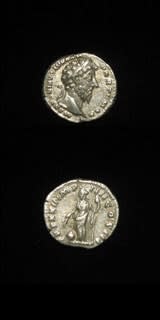Silver Denarius of Emperor Marcus Aurelius, 161 CE - 180 CE
Silver
C.4132
Obverse: M ANTONINVS AVG ARM PARTH MAX; Laureate Bust of the Emperor Facing Right Reverse: TR P XXII IMP IIII COS III; Providentia Standing to the Left, Holding a Sceptre...
Obverse: M ANTONINVS AVG ARM PARTH MAX; Laureate Bust of the Emperor Facing Right
Reverse: TR P XXII IMP IIII COS III; Providentia Standing to the Left, Holding a Sceptre and Using a Baton to Point to a Globe at her Feet
This well-preserved coin in VF+ condition was struck for the emperor Marcus Aurelius. Coinage operates as a propagandist device in all cultures, and particularly during the Roman Empire when the borders were uncertain and internal strife threatened to destabilise the economy. The iconography shows the powerful emperor associating himself with Providentia, the goddess of forethought. The associations between emblems on coins and the intended effect are usually fairly obvious. In this case, the additional presence of the globe underscores the emperor’s imperial ambitions.
Born Marcus Annius Catilius Severus in 121 AD, Marcus Aurelius’ family was well-connected to the aristocracy and ruling classes of Rome, including Hadrian, Trajan and Antoninus Pius. He attracted the attention of Hadrian at a young age, and was nicknamed verissimus – truest. Following the death of Hadrian’s adoptive son Lucius Aurelius, Hadrian named Antoninus as his successor on the condition that he adopt Marcus as well as Lucius Aurelius Verus, the son of his own adopted son, and that they succeed him as emperor in their turn. He acceded to power in 161, aged 40, and adopted the name Marcus Aurelius Antoninus.
The empire grew under his authority, with martial success against the Parthians and Germania, and diplomatic relations with states in Central Asia as far east as Han China. His Meditations, written while on campaign, is still used as a reference for leadership and duty and proposed a manner of rational virtue. He was a Stoic philosopher of considerable note, as well as a family man who took his wife and children with him on his trips around the empire. He had fourteen children by Faustina the Younger, of which only one son and four daughters survived him. He was deified upon his death from the Antonine Plague in 180, and was succeeded by Commodus.
This is a striking and attractive ancient coin.
Reverse: TR P XXII IMP IIII COS III; Providentia Standing to the Left, Holding a Sceptre and Using a Baton to Point to a Globe at her Feet
This well-preserved coin in VF+ condition was struck for the emperor Marcus Aurelius. Coinage operates as a propagandist device in all cultures, and particularly during the Roman Empire when the borders were uncertain and internal strife threatened to destabilise the economy. The iconography shows the powerful emperor associating himself with Providentia, the goddess of forethought. The associations between emblems on coins and the intended effect are usually fairly obvious. In this case, the additional presence of the globe underscores the emperor’s imperial ambitions.
Born Marcus Annius Catilius Severus in 121 AD, Marcus Aurelius’ family was well-connected to the aristocracy and ruling classes of Rome, including Hadrian, Trajan and Antoninus Pius. He attracted the attention of Hadrian at a young age, and was nicknamed verissimus – truest. Following the death of Hadrian’s adoptive son Lucius Aurelius, Hadrian named Antoninus as his successor on the condition that he adopt Marcus as well as Lucius Aurelius Verus, the son of his own adopted son, and that they succeed him as emperor in their turn. He acceded to power in 161, aged 40, and adopted the name Marcus Aurelius Antoninus.
The empire grew under his authority, with martial success against the Parthians and Germania, and diplomatic relations with states in Central Asia as far east as Han China. His Meditations, written while on campaign, is still used as a reference for leadership and duty and proposed a manner of rational virtue. He was a Stoic philosopher of considerable note, as well as a family man who took his wife and children with him on his trips around the empire. He had fourteen children by Faustina the Younger, of which only one son and four daughters survived him. He was deified upon his death from the Antonine Plague in 180, and was succeeded by Commodus.
This is a striking and attractive ancient coin.



